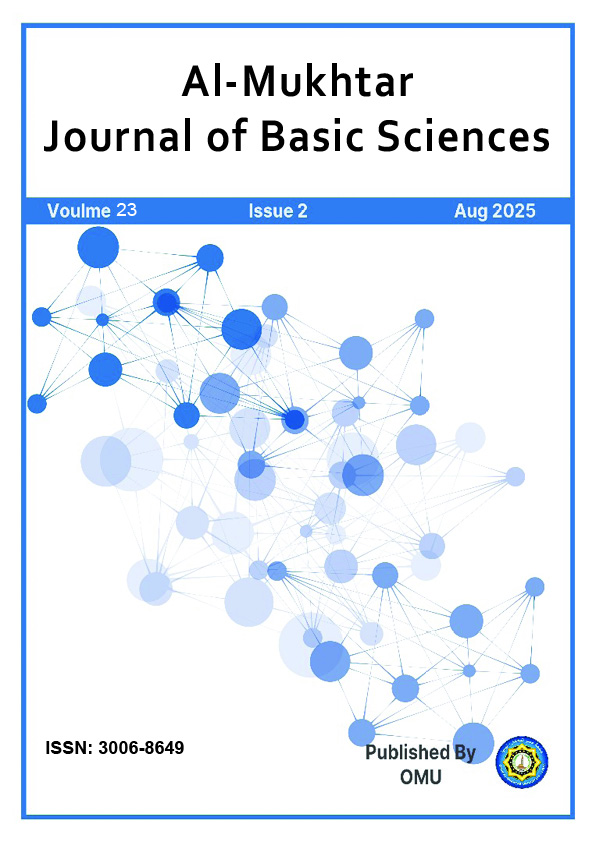Guanidine as A Starting Martial for Preparing a Scale Inhibitor
DOI:
https://doi.org/10.54172/ej6xtg21Keywords:
Guanidine, Scale Inhibitor, Phosphonate Compound, Chelation, Calcium Carbonate, Calcium Sulfate, BiodegradabilityAbstract
This study presents the synthesis and evaluation of a novel phosphonate-based scale inhibitor using guanidine as the starting material. Given guanidine’s highly reactive nature and multiple substitution sites, it was chemically modified by introducing phosphonomethyl groups to enhance its scale inhibition capabilities. The synthesized compound was structurally characterized using FT-IR, ¹H NMR, ¹³C NMR, and mass spectrometry, confirming successful substitution of three hydrogen atoms with phosphonate groups. The compound's performance was assessed through static scale inhibition tests at various temperatures (40°C, 60°C, and 70°C) for calcium carbonate and calcium sulfate, showing significant inhibition at concentrations as low as 20–30 ppm. Titration-based calcium analysis revealed inhibition efficiencies up to 100%. Additionally, the compound demonstrated good compatibility with calcium and acceptable seawater biodegradability over 28 days. These results suggest that the synthesized inhibitor is a promising candidate for environmentally safer and thermally stable scale control in industrial water systems.
References
Ash, M. (2004). Handbook of green chemicals. Synapse Info Resources.
Dakhil, O., Yahya, Y., Abdalkrim, H., & Eltawaty, S. (2022). Chemical Separation of Compounds from Antituberculosis Drug and Their Antibacterial Biological Activity. AlQalam Journal of Medical and Applied Sciences, 274-281.
Delon Jimenez, P. (2014). Improving squeeze scale inhibitor adsorption and flow back characteristics with surfactants University of Stavanger]. http://hdl.handle.net/11250/222726
Demadis, K. (2006). Investing in Chemical Cooling Water Treatment.
Ebetino, F., Francis, M., Rogers, M., & Russell, R. (1998). Mechanisms of action of etidronate and other bisphosphonates. Reviews in Contemporary Pharmacotherapy, 9(4), 233-243.
Garber, K. B., Vincent, L. M., Alexander, J. J., Bean, L. J., Bale, S., & Hegde, M. (2016). Reassessment of genomic sequence variation to harmonize interpretation for personalized medicine. The American Journal of Human Genetics, 99(5), 1140-1149.
Hirabayashi, H., Sawamoto, T., Fujisaki, J., Tokunaga, Y., Kimura, S., & Hata, T. (2002). Dose‐dependent pharmacokinetics and disposition of bisphosphonic prodrug of diclofenac based on osteotropic drug delivery system (ODDS). Biopharmaceutics & drug disposition, 23(8), 307-315.
Jordan, M., & Mackay, E. J. (2007). Scale Control in Chalk Reservoirs: The Challenge of Understanding the Impact of Reservoir Processes and Optimizing Scale Management by Chemical Placement and Retention—From the Laboratory to the Field. SPE Middle East Oil and Gas Show and Conference,
Kelland, M. A. (2014). Production Chemicals for the Oil and Gas Industry.
Kim, S.-H., Semenya, D., & Castagnolo, D. (2021). Antimicrobial drugs bearing guanidine moieties: A review. European journal of medicinal chemistry, 216, 113293.
Kiran, Y., Reddy, C. D., Gunasekar, D., Reddy, C. S., Leon, A., & Barbosa, L. C. (2008). Synthesis and anticancer activity of new class of bisphosphonates/phosphanamidates. European journal of medicinal chemistry, 43(4), 885-892.
Kukhar, V. P., & Hudson, H. R. (2000). Aminophosphonic and aminophosphinic acids: Chemistry and biological activity. John Wiley & Sons.
Mady, M. F., & Kelland, M. A. (2017). Overview of the synthesis of salts of organophosphonic acids and their application to the management of oilfield scale. Energy & Fuels, 31(5), 4603-4615.
Maeda, K. (2004). Metal phosphonate open-framework materials. Microporous and mesoporous materials, 73(1-2), 47-55.
Moussa, A. (2014). Two Functional Guanidine Groups Are Responsible for the Biological Activity of Streptomycin and Functionally Equivalent Molecules. J. Chromatogr. Sep. Tech, 5, 1-3.
Nowack, B. (2003). Environmental chemistry of phosphonates. Water research, 37(11), 2533-2546.
Popov, K., Kovaleva, N., Rudakova, G. Y., Kombarova, S., & Larchenko, V. (2016). Recent state-of-the-art of biodegradable scale inhibitors for cooling-water treatment applications. Thermal Engineering, 63(2), 122-129.
Rodan, G. A., & Martin, T. J. (2000). Therapeutic approaches to bone diseases. Science, 289(5484), 1508-1514.
Sparidans, R. W., Twiss, I. M., & Talbot, S. (1998). Bisphosphonates in bone diseases. Pharmacy World and Science, 20(5), 206-213.
Woodward, G., Jones, C., & Davis, K. (2004). Novel Phosphonocarboxylic Acid Esters. International Patent Application WO2004/002994.
Zamperini, C., Maccari, G., Deodato, D., Pasero, C., D’Agostino, I., Orofino, F., De Luca, F., Dreassi, E., Docquier, J.-D., & Botta, M. (2017). Identification, synthesis and biological activity of alkyl-guanidine oligomers as potent antibacterial agents. Scientific reports, 7(1), 8251.
Downloads
Published
Issue
Section
License

This work is licensed under a Creative Commons Attribution-NonCommercial 4.0 International License.
Copyright of the articles Published by Al-Mukhtar Journal of Basic Sciences (MJBS) is retained by the author(s), who grant MJBS a license to publish the article. Authors also grant any third party the right to use the article freely as long as its integrity is maintained and its original authors and cite MJSc as the original publisher. Also, they accept the article remains published by the MJBS website (except in the occasion of a retraction of the article).












